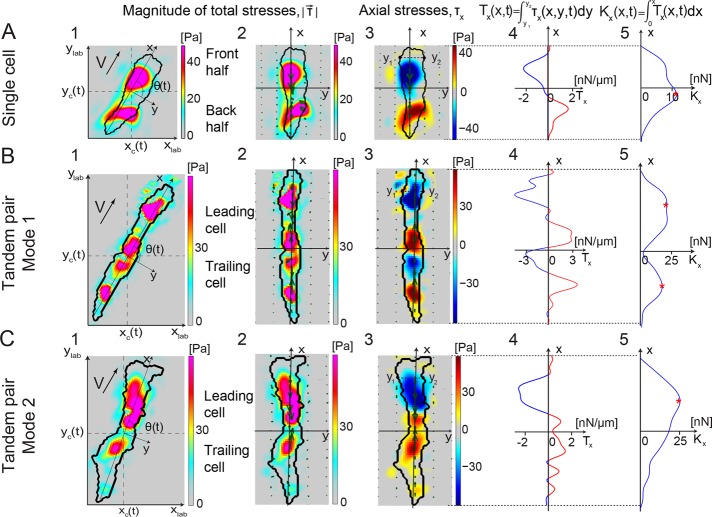FIGURE 1:
Characterization of the locomotion dynamics of amoeboid tandem pairs with high spatiotemporal resolution. Traction stresses (force/area; 1–3), tension (force/length; 4), and cumulative integral of the tension (force; 5) along the major axis for a representative single cell (A) and pairs of tandem cells (B, C) at a given instant of time. Color bars at the right side of each traction stress map indicate stress values in pascals. 1) Color contours mapping the instantaneous magnitude of the traction stress,  , in the lab reference frame (xlab, ylab). The black contour shows the cell (or cell pair) outline. The axes (x, y) are aligned with the principal axes of the cell (or cell pair), and their origin is located at the center of mass of the cell (or cell pair) (xc, yc). The thick black arrow shows the direction of motion of the cell (or cell pair). 2) Instantaneous magnitude of the traction stresses in a reference frame rotated to coincide with (x, y). Superimposed green arrows show the intensity and direction of the traction stresses. 3) Axial traction stress, τx. Stresses pointing toward the cell (or cell pair) front are considered positive and are indicated with red, and negative stresses are shown in blue. 4) Integral of the axial traction stress across the cell (or cell pair) width (axial tension, Tx) as a function of the position along the length. The horizontal axis displays the tension value in nanonewtons/millimeter. Positive and negative values are indicated by red and blue, respectively. 5) Integral of the axial tension across the cell (or cell pair) length (cumulative integral of tension or internal axial tension, Kx) as a function of the position along the length. The horizontal axis displays the Kx values in nanonewtons. The number of maxima of Kx (red asterisks) indicates whether the cell (or cell pair) moves as one contractile dipole or two. (A) A single cell. (B, C) A cell pair using two different modes of motility: mode 1 (B), in which the pair acts as two contractile dipoles (with four TAs), and mode 2 (C), in which the pair acts as one dipole (with three TAs).
, in the lab reference frame (xlab, ylab). The black contour shows the cell (or cell pair) outline. The axes (x, y) are aligned with the principal axes of the cell (or cell pair), and their origin is located at the center of mass of the cell (or cell pair) (xc, yc). The thick black arrow shows the direction of motion of the cell (or cell pair). 2) Instantaneous magnitude of the traction stresses in a reference frame rotated to coincide with (x, y). Superimposed green arrows show the intensity and direction of the traction stresses. 3) Axial traction stress, τx. Stresses pointing toward the cell (or cell pair) front are considered positive and are indicated with red, and negative stresses are shown in blue. 4) Integral of the axial traction stress across the cell (or cell pair) width (axial tension, Tx) as a function of the position along the length. The horizontal axis displays the tension value in nanonewtons/millimeter. Positive and negative values are indicated by red and blue, respectively. 5) Integral of the axial tension across the cell (or cell pair) length (cumulative integral of tension or internal axial tension, Kx) as a function of the position along the length. The horizontal axis displays the Kx values in nanonewtons. The number of maxima of Kx (red asterisks) indicates whether the cell (or cell pair) moves as one contractile dipole or two. (A) A single cell. (B, C) A cell pair using two different modes of motility: mode 1 (B), in which the pair acts as two contractile dipoles (with four TAs), and mode 2 (C), in which the pair acts as one dipole (with three TAs).

